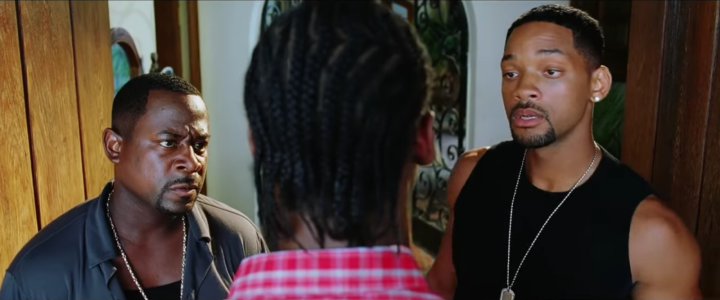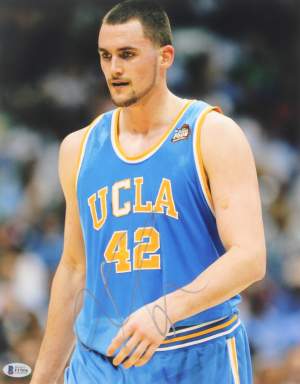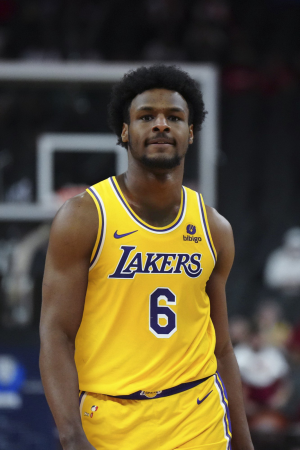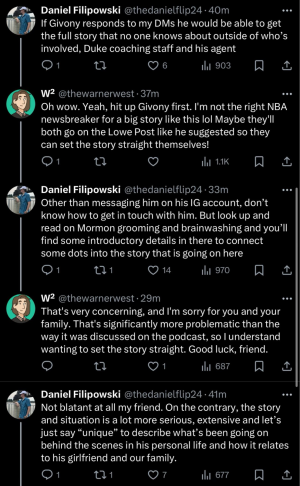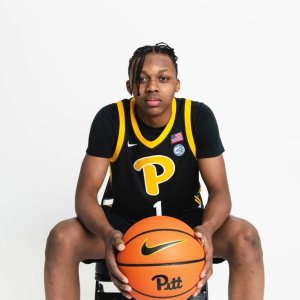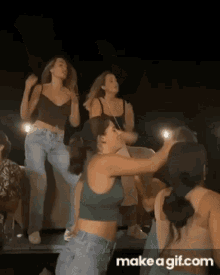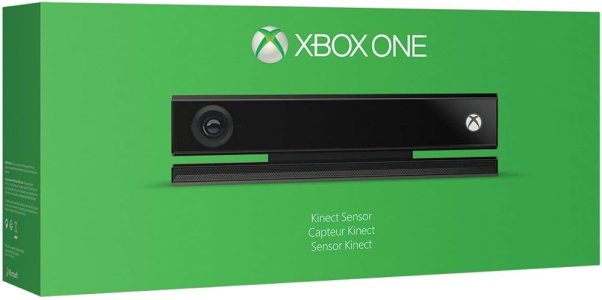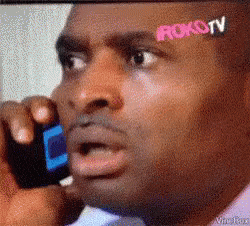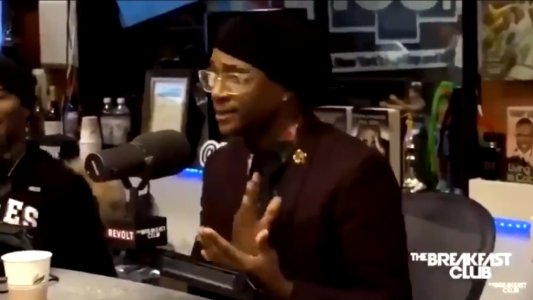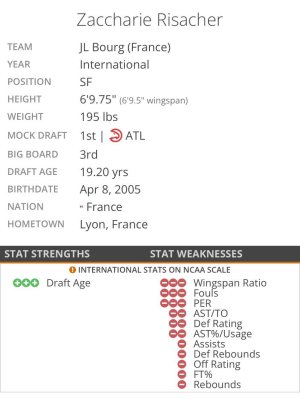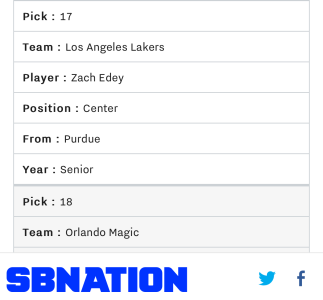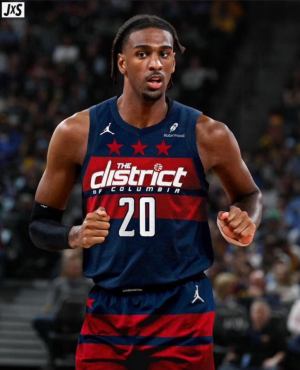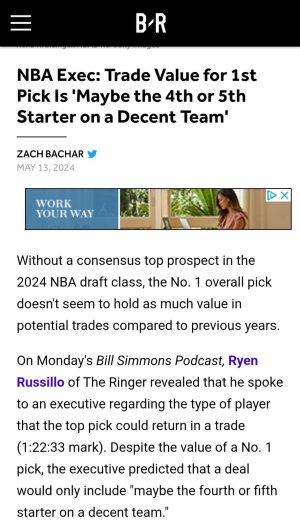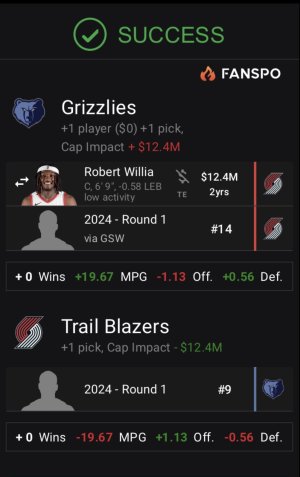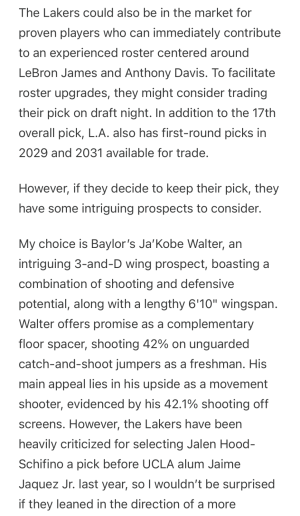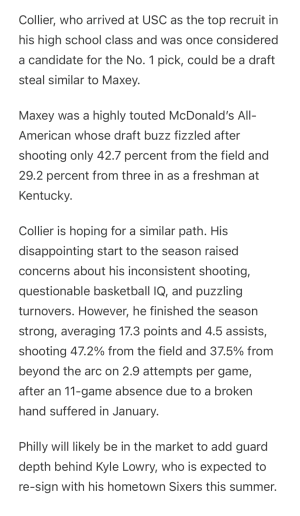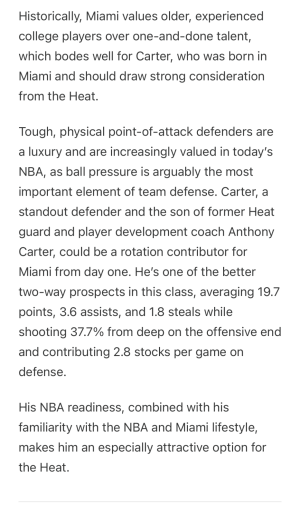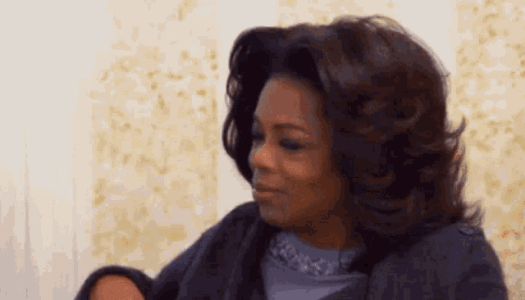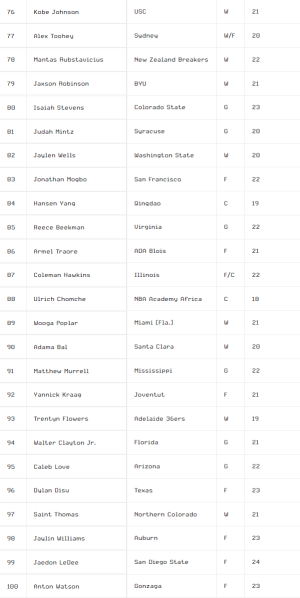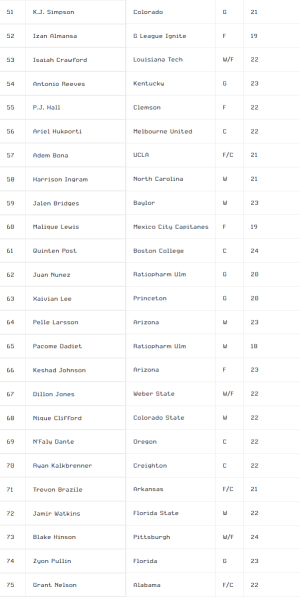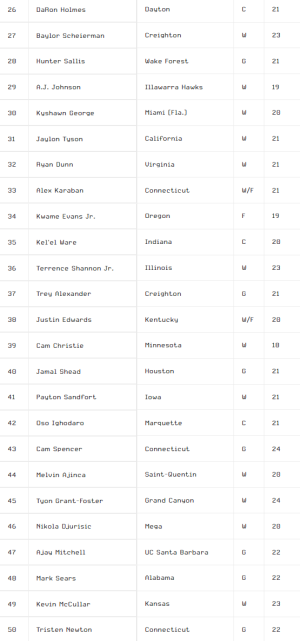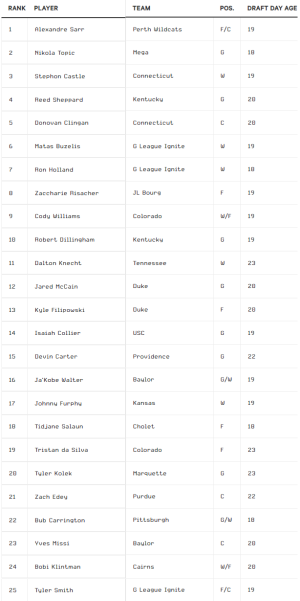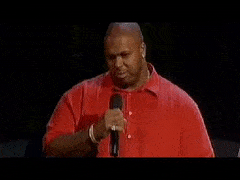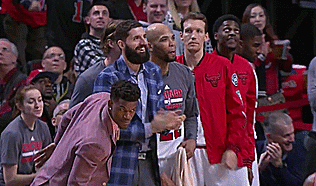NBA Draft 2024: Ron Holland sits No. 1 on John Hollinger’s Top 20 prospects list
If you’re looking for the next Victor Wembanyama, you’ve come to the wrong place.
When it comes to the 2024 NBA Draft, we might not even have the next Victor Oladipo. Victor Khryapa? That might be doable. The consensus among talent evaluators is that this is the worst draft since 2013, when Anthony Bennett was the top pick and the final 33 selections produced just three rotation players.
Yet there is quality in any draft if you look hard enough — even 2013 gave us Rudy Gobert and Giannis Antetokounmpo, not to mention Oladipo with the second pick. Teams are looking high and low on the draft board for those unappreciated talents who might have been graded too low. As miserable as the 2013 draft was, it still yielded six undrafted rotation players, including three (Robert Covington, Seth Curry and Daniel Theis) who are still in the league.
Nonetheless, this draft is a different beast from the last few. The prize for winning the lottery is … uncertain, at best. There has been virtually no consensus on whom the No. 1 pick should be, and several names have been mooted as potential top picks at some point during the past 12 months.
The reason, alas, is that no player has stood out to the extent Wembanyama or even No. 2 pick Brandon Miller did a year ago. That’s especially true from this year’s college class; four of my top seven players didn’t play in the NCAA this past season, and I’ve seen other boards with a 5-for-5 clean sweep at the top.
Despite those obstacles, and the risk that somebody I stamp as a high-lottery pick will be a Bennett-sized flop, we press onward. I assure you 58 players will be picked in June’s draft (two second-round picks have been forfeited, taking us down from the usual 60), and inevitably, at least a few of them will turn out to be pretty good.
I’m revealing my top 20 players on the heels of the lottery and will get to the rest once we know which players are staying in the draft and which ones aren’t. (Virtually all top-20-caliber players stay in, so that part is easier.)
Here’s what my board looks like. (Ages listed are as of draft night):
Tier I - Best bets in bad class
1. Ron Holland
F G-LEAGUE IGNITE Age:18 Height: 6-8 Position: F
Ron Holland? Yes, Ron Holland. Let’s start with the negatives first:
I think Holland is only going to measure 6-6 at the NBA Draft Combine, he shot a ghastly 24 percent from 3 in the G League, and his avert-your-eyes start to the G League season — including an 11-turnover game — had scouts shuddering.
Now, for the good news: He came into the year as the top-rated player on most boards, had better numbers with G League Ignite than any other one-and-done in its history … and somehow went careening down draft boards anyway, even in a draft year where absolutely nobody came in and claimed the top spot for themselves.
I don’t really get it. The biggest complaint with Holland is his lack of efficiency, but that was baked in the second Ignite built this roster. Virtually any teenager put in a situation where he has to carry a 30 percent usage rate is going to struggle; we saw it with LaMelo Ball in Australia and Scoot Henderson in Portland. Holland was no different, especially since he’s not a natural point guard in the first place. Playing on a team with no real creator, he often had to call his own number against loaded-up defenses.
Did he get tunnel vision once he put it on the floor? Absolutely. Was it so tragic to rule him out versus other non-overwhelming options? I don’t think so, especially as the season wore on.
Holland's numbers stack up well against Jalen Green’s with Ignite and are superior to every other Ignite perimeter player who has come through. That happened despite Holland missing the final two months of the season, when his increasing experience would have given him an edge and when the rest of the G League is at its most depleted due to call-ups and fewer assignment players.
In his Ignite season, Green posted a 15.4 PER with 61.3 percent true shooting; Holland had a 15.8 PER on 56.5 percent. The shooting numbers were bad, but Green played on a more coherent team and thus also was only asked to carry a 23 percent usage rate at this level, not Holland’s 28 percent. Also, keep in mind that Holland’s free-throw rate was pretty massive for a perimeter player; four free-throw attempts per game may not seem like much until you remember the G League shoots one attempt that counts for two points. Only 10 players in the whole G League matched his rate. And even with Holland’s brutal early turnover issues, his assist and turnover rates were essentially the same as Green’s age-18 season.
Green would be the No. 1 pick in this draft; I think Holland should be too.
The other reason to like Holland is his defense. His 3.5 percent steal rate stands out; some iffy gambles spiked the total, but there is real talent (and fire) on this end. Overall, his rates of rebounds, steals and blocks compare favorably to former Ignite lottery pick Dyson Daniels, for instance, who has now become an awesome defender at the NBA level. I think Holland has similar pathways to being elite at this end.
On top of that, there’s the good ol’ eye test. I’ve seen Holland shoot a ton, both before games and during them, having watched him in person several times over the last year. He has a low push shot that needs some work, but he’s also not a 24 percent 3-point shooter. His 72.8 percent mark from the line is a more accurate tell on where he stands as a shooter — he isn't Stephen Curry, but his shot isn’t broken either. Just reaching the point where he makes one in three would make him a potent two-way wing, and that feels attainable.
Lastly, consider Holland’s age. With a July 2005 birthdate, he’s nearly a full year younger than several other players vying for places with him in the high lottery: He's six months younger than Rob Dillingham, nine months younger than Stephon Castle or Matas Buzelis and more than a year younger than Donovan Clingan and Reed Sheppard. Teams get caught on class year, but birth year is what matters.
It's not a slam dunk, and you could make a credible case for several players, but Holland has been the top player on my board since the 2023 Hoop Summit. He still has the best overall résumé.
2. Stephon Castle
W CONNECTICUT Age: 19 Height: 6-6 Position: W
For a league where everyone is looking for big, ballhandling wings, teams sure seem to like finding reasons to avoid taking one in the draft. I’ve seen Castle ranked much lower than this on several draft boards, and I’m not sure I get it.
Castle isn’t perfect — questions about his shooting persist — but in this draft, he stands out as a plus defender from day one who also adds secondary ballhandling and creation chops. A 6-6 freshman wing with 6.2 assists per 100 possessions and a 2:1 assist-to-turnover ratio certainly stands out, especially since he did so for a team that cruised to the national title.
Like Holland above, Castle has high-end possibilities on the defensive end that help provide a solid floor even if he doesn’t hit his offensive ceiling. He was impressive contesting shots at the end of plays and using verticality, although he did foul too much for a perimeter player. In terms of lateral quickness, I wouldn’t quite put him on the top shelf, but he was good — straight-line drives weren’t beating him, but sometimes quick stops and changes of direction got him a step behind.
Getting back to the offense end, the shooting question looms large. Castle's balance and form on his shot varies quite a bit depending on whether he’s shooting off the catch, off the dribble going left or off the dribble going right. At times, his arms look like they’re fighting each other, with the guide hand getting too much in the way.
On the other hand, his size, athleticism and ball skills should allow him to thrive in the more open floor of the NBA, and the more the ball in his hands, the less of an issue his catch-and-shoot jumper becomes. Even with his issues shooting, Castle made 75.5 percent from the line last season.
3. Donovan Clingan
C CONNECTICUT Age: 20 Height: 7-2 Position: C
Longtime readers know I don’t put as much stock in drafting centers as I do other positions. If it weren’t for that, Clingan would have a case for the top spot on my board. Even with my anti-center bias, Clingan seems like a fairly obvious starting 5 man with a possible All-Star ceiling. At this point in a weak draft, that becomes an enticing value proposition.
Clingan isn’t just tall, he’s huge all over, with thick legs and a strong frame from top to bottom. He’s capable of overwhelming smaller players in the post, but UConn didn’t bring everything to a screeching halt to run stuff for him the way, say, Purdue did for Zach Edey. Instead, the Huskies took advantage of Clingan’s facility as a passer from the elbows. His best work on the block often came in early offense with quick transition seals; he runs the floor shockingly well for his size. Watch here, for instance, as he first smothers a drive at the rim, then cooks four of the five opponents in transition despite starting from his own baseline. (Bonus: That's my No. 2 prospect, Stephon Castle, throwing the crosscourt dime to set up the finish.)
Defense, of course, is where bigs make their dough, and Clingan excelled here. Relative to recent drafted centers, his 12.2 percent career block rate in college isn’t quite in Walker Kessler territory, but it’s superior to that of Mark Williams or Jalen Duren and nearly matches Chet Holmgren’s 12.9 percent. On top of that, Clingan showed well on tape in picking up smaller players on the perimeter and sliding with them to meet their shot at the rim. Watch him against Illinois prospect Terrence Shannon Jr., for instance, in the NCAA Tournament.
While Clingan only shot 55.8 percent from the line for his career at UConn, there is some level of hope he can stretch out a bit. Watching him shoot before Huskies games, his stroke looked surprisingly game-ready.
Clingan’s draft combine medical report will be important since he had a foot injury that teams will want to research. But heading into the week in Chicago, nobody seemed overly concerned that it could crater his stock. The injury was to a tendon, not a bone, and the latter is more what freaks teams out with players of this size.
4. Reed Sheppard
G KENTUCKY Age: 20 Height:6-3 Position: G
There are some obvious standout items on Sheppard’s prospect resume, starting with his sizzling 52.1 percent 3-point mark in his lone season in Lexington.
He backed up that shooting display with 83.1 percent marksmanship from the charity stripe. Equally impressive for a small guard, he shot 55 percent on 2s and had a high assist rate (8.4 dimes per 100 possessions) for a player who was often playing off the ball. His knack for hit-ahead passes particularly stood out.
Sheppard’s shooting volume wasn’t as high as you might expect for somebody this successful from 3, but the eye test reveals a quick, compact, textbook release off his right shoulder that could allow him to up his volume if he hunts the shot more. Sheppard also showed enough flashes of shot creation and off-the-dribble juice to think he could play point guard full time at the next level, which is important given his size. It wasn’t needed at Kentucky, however, as he played nearly all his minutes alongside the zippy Rob Dillingham (See below).
Sheppard’s defensive event creation rate also stood out. A block rate of 2.5 percent is basically unheard of for a player this size (he swatted 23 shots in 33 games — Kentucky’s starting center, by comparison, blocked 26), and his steal rate of 4.5 percent was phenomenal.
That said, his steal rate doesn’t account for some of his defensive weaknesses, as he resorted to gambling at times to make up for his size deficiencies and iffy lateral sliding. Sheppard’s anticipation is off the charts and he’s great in passing lanes, but he doesn’t put a ton of heat on the ball one-on-one and at times was beaten on straight-line drives with alarming ease.
The tape showed multiple instances like this one where he’s stuck with his feet while a guard glides past him.
As a smaller player with short arms, Sheppard also may struggle if he has to play the wing. That’s one reason he had to gamble so much for steals in the first place.
That said, there are too many positives in Sheppard’s profile to push him any lower than this. At worst, he’s a knockdown shooter, and high rates of assists and steals in particular historically indicate a player who can progress heavily in other areas as he develops.
Tier II - Promising teenagers
5. Alex Sarr
C PERTH WILDCATS Age: 19 Height: 7-1 Position: C
The National Basketball League is improving every year, but it’s still weak sauce compared to most of the European leagues, so I’m slowing my roll a bit on the Sarr enthusiasm relative to most of my colleagues. He had a good, but not dominant year for Perth, and watching him in person before the season raised questions regarding his offensive level.
That said, Sarr is a switchable defender on the perimeter for day one. His defense might be the most bankable skill set in this whole draft. He flies up and down the court, slides his feet to contain guards on the perimeter, gets his hands on balls and can protect the rim. In his first year Down Under, he led the NBL in block rate. He did it with a remarkably low foul rate for a big man, too, with just 41 personals in 30 games.
If you’re looking for physicality on top of that package, you have perhaps come to the wrong place. Sarr will undoubtedly improve in this phase as his body fills out, and the extreme physicality of the NBL may have highlighted this weakness a bit more than other environments. However, a 13.3 percent rebound rate from a 7-1 center is sad-trombone stuff and a good indication of his deficits here. (By comparison, Ariel Hukporti, a meh 7-footer who will likely be picked late in the second round, had a 21.6 percent rebound rate in the same league.)
Sarr’s lack of physicality arrives over the offensive end, where he has no post game to speak of. He tries to make up for it with 3-point shooting and play from the elbows, but he’s still not NBA-caliber in these realms. He tends to dribble himself into trouble when he puts it on the floor more than once, and his 3-point shot has a sidespin on it that makes it difficult to trust. (He shot 27.6 percent from 3 and 70.7 percent from the line in Australia.)
He could perhaps contribute more profitably as a rim runner, especially since he already seems to make decent decisions out of short-roll situations — an even assist-turnover rate from an 18-year-old center is nothing to sneeze at.
However, that takes us to another issue that has me a bit lower on Sarr than consensus: I don’t totally trust his hands. His rebound rate isn’t low just from a lack of physicality; he also was phenomenally unable to pull down contested boards in traffic, especially with one hand. Sarr’s defense alone makes him a notable prospect in this draft, but his offensive shortcomings are too limiting for me to place him at the top of the board.
6. Nikola Topić
G CRVENA ZVEZDA Age: 18 Height: 6-6 Position: G
The Adriatic League isn’t what it once was, but you still have to give Topić respect for playing at a high level as a teenager in a professional league. He’s still playing games and racking up stats, but through Friday, he had posted a 20.0 PER while playing a major shot-creation role for two different teams as an 18-year-old. (His August 2005 birthdate makes him one of the few players in this draft who is younger than Holland.)
Topić also was the MVP of both age-group tournaments he played in during the summer of 2023: The U18 European championship and the Belgrade NIJT tournament. Those all make a prima facie case that Topić should be one of the highest-rated players on the draft board. He’s a big guard who can get downhill and create plays for others. This is the archetype every team seeks out, so it’s no accident I have three big wings near the top of my list.
The shooting question marks about Topić might be overblown as well. He’s only made 26 3-pointers in 22 games, which is certainly a concern. On the other hand, he’s shot 88 and 89 percent from the line the past two seasons. How many guys are this good from the line and total zeros from 3? He needs to get into his jumper more comfortably off the dribble, but the raw material is there.
Of more concern, perhaps, is his lack of athletic event creation and overall athleticism. He had low rates of blocks, steals and rebounds in the Adriatic League and projects as a below-average defender at the NBA level. To use one obvious comparison, even Luka Dončić had a massively higher output in these areas before coming to the NBA. Scouts bring up Josh Giddey when they mention comps for Topić, but I suspect Topić will shoot better and rebound less. Topić also had an in-season knee injury that NBA teams will dig in on for more information, but he’s already back playing, so nobody expects it to harm his stock.
7. Matas Buzelis
F G-LEAGUE IGNITE Age: 19 Height: 6-10 Position: F
While I find it bizarre that a lot of boards have Buzelis over Holland when Holland was clearly the better player, Buzelis definitely has some interesting traits that could make him an effective stretch big in time. While he played exclusively at forward with Ignite, I think he could be a stretch five in the NBA once he gets into his 20s and his body fills out.
Buzelis only shot 26.1 percent from 3 with Ignite last season, but don’t believe that number. Much like Holland above, his stroke isn’t that of a 26-percenter, and his 69.6 percent free-throw mark considerably shorts his shooting ability as well. Buzelis has a nice-looking stroke with few obvious flaws; I’d be very surprised if he wasn’t a league-average shooter, at the very least, by his third season. It seems like the league has priced this into his draft stock as well.
Even with the bad shooting numbers, Buzelis’ overall numbers in the G League weren’t awful: 53 percent shooting on 2s, a 13.6 PER and 55.7 percent true shooting. His Ignite numbers, for example, compare favorably to Jonathan Kuminga’s. As with Holland above, those numbers likely would have looked better had he been afforded the chance to play on a real team with an actual point guard.
Offensively, Buzelis doesn’t have the shot-creation upside of some of the other non-centers ahead of him on this list. He can really jump, but he doesn't have a lot of burst on the perimeter and struggles to get separation, which limits his advantage creation. In time, however, he should grow more adept at working size mismatches on switches for chances closer to the basket. Additionally, he's able to pop off the ground near the basket to finish transitions or cuts with strong dunks.
Defensively, the long-term promise is more apparent as a big forward who can guard multiple positions, and Buzelis takes pride on that end. He moves well laterally for a player of his size and has some real pop as a leaper that allows him to block shots – a 5.7 percent block rate for a non-center jumps off the page, and his 12 percent rebound rate is respectable for an 18-year-old four playing against grown men. Overall, you can see Detlef Schrempf-type upside if the skill package comes together and a floor of rotation-level usefulness as long as his shooting is even remotely acceptable.
8. Rob Dillingham
G KENTUCKY Age: 19 Height: 6-3 Position: G
I mentioned above that it’s tough to hand a 30 percent usage rate to an 18-year-old. Well, that’s what Kentucky did with DiIlingham, and he was still awesome. Granted, it was in a bench role that let him cook against some backups and play shorter shifts, but still. Dillingham is an electric offensive player who shot 44.4 percent from 3, averaged 35.3 points per 100 possessions and posted two assists for every turnover.
Dillingham’s shooting might not match his college 3-point numbers. He made just 79.6 percent from the line and has a quarter turn sideways getting into his shot; it’s not as bad as, say, Cameron Payne’s, but his right foot is well forward when he shoots and he may end up susceptible to foot-on-line long 2s. He’s a decent but hardly elite passer right now — it’s good enough to keep him at the point, but he’s playing more as a scorer. Dillingham’s turnover rate also escalated in conference play, a worrying trend.
Between those weaknesses and his suspect defense, he profiles more as a perennial Sixth Man of the Year candidate than a long-term starter. Much like, say, Lou Williams, Dillingham is really fast but doesn’t really weaponize his speed or quickness on defense. He had a very low rate of steals for a player of this type, and the tape showed him getting cooked regularly.
Given his small frame (he’s listed at 170 pounds), Dillingham will get up into the ball to try to prevent bigger players from shooting over him. However, he has trouble with crossovers and second moves and leaves his feet on any decent shot fake. In a related story, his foul rate of 6.1 per 100 was terrible for a non-big; in fact, it’s the worst of any legit perimeter prospect in this draft. Overall, Dillingham’s effort level was solid enough that he probably won’t be Trae Young-level bad on defense, but he certainly won’t be good. That puts a bit of a cap on his stock.
Tier III - No-frills college vets
9. Kyle Filipowski
F, C DUKE Age: 20 Height: 7-0 Position: F, C
Filipowski’s case for being a lottery pick doesn’t get enough attention. There are legitimate questions about whether he shoots well enough to be a true stretch big. If he can’t, he profiles as something along the lines of “a more defensively capable Frank Kaminsky,” which is draftable, but not this high. You’re banking on Filipowski refining his perimeter game to the point that it weaponizes his superior ability to dribble and pass for his size.
Filipowski’s shot is going to take some work; He hit 31.4 percent from 3 and 71.8 percent from the line in his two seasons at Duke. Watching him before several of Duke’s games, he had trouble controlling the spin on his shot and preventing his guide hand from affecting his shot’s flight.
That matters, because he’s more of a combo big than a true five at both ends of the court. He doesn’t have the broad shoulders or superior length you’d expect from an interior presence on defense, and while he's a good passer on the block and can score against mismatches, he’s not going to physically overwhelm rival bigs.
Filipowski can have more success just playing in the flow of the game, making the right pass and getting to the rim on his own once he has an advantage. It’s easy to see how even a middling 3-point shot could be a force multiplier for those skills.
Defensively, Filipowski’s ability to defend on the perimeter could make him useful as the type of big four (think Al Horford, Maxi Kleber or Karl-Anthony Towns) who has low-key come back into vogue recently. His tape was eye-popping. He isn't just some "serviceable" switch big; he can embarrass smaller wings who try him one-on-one. A 2.5 percent career steal rate from a 7-footer is awesome, and the Dukies were very comfortable leaving him on an island against guards. In fact, you could build an entire five-minute YouTube montage of guards thinking they were going to cook Filipowski once they got a switch, only to find out in a relatively embarrassing way that they didn’t have any advantage.
10. Devin Carter
G PROVIDENCE Age: 22 Height: 6-3 Position: G
An upperclassman! What is this madness? Carter is a wizened graybeard of 22, but his season was good enough that he presents a real possibility of being an immediate rotation player – even a starter – depending on where he lands.
For me, Carter is the guy the Miami Heat take in the middle of the first round, and after he has 18 points and 10 rebounds in a December game in Boston, the rest of the league slaps its collective head and says, "Why didn't we do that?"
The son of former Heat guard Anthony Carter, Devin shoots a moon-ball jumper just like his dad, but evened out the kinks in his stroke this past season, improving to 37.7 percent from 3 while nearly doubling his volume to an impressive 11.2 per 100 possessions. He also shot a more pedestrian 74.9 percent from the line, which might soften our projection for how well he’ll shoot 3s as a pro.
Nonetheless, that’s far from his only skill. Carter has been a “little things” guy his whole career: a hard-playing, crafty player with a preposterous 23 percent defensive rebound rate as a 6-3 guard. He led the Big East in this category – Donovan Clingan plays in his conference!
Offensively, Carter is more of an off-ball guard because he doesn’t have an electric first step and he isn’t an elite passer. He was a bit turnover-prone, too, but had enough finishing skill to shoot 56.3 percent on 2s with a plus free-throw rate. Realistically, he will be a secondary shot creator at the next level at either guard spot.
His defense, however, has a chance to make him stand out. Carter has great instincts as an off-ball defender, getting nearly two steals a game and blocking 32 shots in 33 games despite his small stature. As an on-ball defender, he didn’t overdo it with ball pressure but excelled at playing angles and funneling players to low-value spots before challenging shots late. Carter also fouled remarkably infrequently for a player who generated so many defensive events. With his size, one worries a bit about big wings playing over the top of him, but that’s about the extent of the concerns.
Overall, Carter may not offer as much right-tail upside as some of the players below him on this list given his age and middling athleticism, but much like Jaime Jaquez Jr. a year ago, he offers the likelihood of immediate playability for the right team.
Tier IV - Talented but I have questions
11. Johnny Furphy
F KANSAS Age: 19 Height: 6-9 Position: F
This is higher than a lot of people have him, but I’m a big fan of what Furphy offers. He has positional size for a combo forward and the mobility to check smaller players on the perimeter, but he also grades out as a plus shooter who can supply some extra athletic pop as a finisher on cuts and in transition.
Furphy is skinny and needs to fill out, but his statistical production was a bit better than that of similar physical archetypes Zaccharie Risacher and Cody Williams (both below) despite coming over from Australia to play for Kansas. While Furphy didn’t shoot often and wasn’t asked to do much off the dribble, he shot 64.2 percent on 2s with a high free-throw rate. From the perimeter, his stats were more ordinary (35.2 percent from 3, 76.5 percent from the line), but he shoots 3s with relatively high volume, and both his shooting form and incoming rep suggest he is capable of better.
Defensively, Furphy had some trouble with quick guards, and physicality sometimes gave him trouble when players could shrug him off with a shoulder to get room for a shot. That should lessen as his body fills out, but he’s always going to be light for this size. That said, he had the length and quick hops to get back into plays to contest or block shots, even when initially beaten. His 11.7 percent rebound rate is pretty impressive for a guy who projects as a three at the next level.
We’re into a new tier here where the projections are more questionable, but of this group, I’d argue Furphy has the most realistic upside to turn into a long-term starter.
12. Isaiah Collier
G USC Age: 19 Height: 6-5 Position: G
The No. 1 pick hype was overblown – Collier has too many warts in his offensive game to warrant a selection that high, with iffy shooting, too many turnovers and a bully-ball style limiting his appeal as a leading man at the offensive end. That said, he has some similarities to Holland: He was asked to carry a 30 percent usage rate for a bad team; what did you think would happen?
But, um, can we talk about his defense? Collier was a bit inconsistent on that end, but his best plays were off the charts. Here is a play where he ends up getting scored on … but look at the multiple efforts and lateral slides that preceded it. (Collier is No. 1 in dark jersey, starting at the bottom of the screen).
The data says Collier pilfered 3.2 steals per 100 possessions, and while this was partly due to USC’s gambling system (teammate Kobe Johnson nicked 4.1, for instance), Collier’s tape in one-on-one defense is pretty impressive. You’d just wish he’d followed that up on the boards; for a strong 6-5 guard, his 5.6 percent rebound rate was pathetic.
Offensively, Collier shoots a flick off the top of his head with inconsistent arc, which will need some work. He shot 33.8 percent from 3 and 67.3 percent from the line at USC, and if you watched his pregame work, those are believable numbers. He also had some mind-boggling turnovers, with a strange proclivity for throwing terribly inaccurate passes even when he’d made the correct read.
He also probably needs to play off the ball at the next level; he struggles to elevate at the rim, doesn’t show much left-hand finishing skill and he is just an average decision-maker. Given his tank frame, he may even evolve into a Lu Dort type if he can straighten out his catch-and-shoot game. More likely, he’s a secondary scorer as a slasher who can also defend the perimeter and guard up in size. That gives him value, even if he's not No. 1 pick material.
13. Zaccharie Risacher
F JL BOURG Age: 19 Height: 6-8 Position: F
I’m not sure any player’s stock has yo-yo’d as much as Risacher’s in the last year. After a disappointing performance at the Nike Hoop Summit followed a poor shooting year in France, Risacher was seen by some as a fringe first-rounder. This season, his 3-point percentage rebounded sharply, and Risacher suddenly moved into the discussion for the No. 1 pick. Both pendulum swings now seem like overcorrections, with shooting variance spiking the punch scouts were drinking.
Let’s take a step back. Risacher has obvious pathways to rotation-level usefulness: He’s a tall wing who can move on the perimeter and showed very good lateral quickness in particular. He has a solid feel for the game, and his shot, while a bit hitchy at the top, is reliable enough to demand the opponent guard him.
But once we start raising the bar to lottery-level pick, the questions become louder. One thing in particular that NBA teams have consistently underpriced is that the French League just isn’t that good. Turkey and Spain, to name two, are much, much stronger. It’s one thing if a guy like Clint Capela or Victor Wembanyama destroys the league as a teenager, but Risacher isn’t doing that – he has a modest 14.8 PER in 57 games for JL Bourg. At the French League level (and in EuroCup play as well, one notch below the EuroLeague), he’s fine … but he’s not an elite player.
Historically, drafting players like this from France hasn’t ended well. The two perimeter players in the last two decades who hit as imports from this league were Evan Fournier and Nic Batum, who both had much more impressive numbers in their pre-draft seasons. The ones who didn’t – the Frank Ntilikinas and Sekou Doumbouyas – were overdrafted based on seasons a bit worse than the one Risacher is having, but Risacher’s statistical profile is much closer to those guys than to Batum and Fournier. (I’m leaving Bilal Coulibaly out of this for now, as we don’t know how the story ends.)
History isn’t destiny, and it’s possible Risacher outperforms these comps. But his lack of on-ball juice at this level is a tell that his upside is probably more as a plus role player than a star, especially given that his shooting isn’t a lock and his thin build and lack of toughness raise added questions.
Risacher has shot better this year, hitting 38.9 percent of his 3s, but it hasn’t been on huge volume and his pedestrian shooting marks on 2s (51.6 percent) and from the line (71.9 percent) haven’t budged at all from a year earlier. Overall, big forwards are rare enough that he’s worth drafting, but a team would feel much better about the pick if it isn’t counting on him becoming a starter.
14. Dalton Knecht
G TENNESSEE Age: 23 Height: 6-6 Position: G
Let’s start with the positives. There’s a reason his name is pronounced “connect”: This dude shot it. Knecht had both the highest 3-point frequency and accuracy of any legit top-50 prospect in this draft. More impressively, he did this not as a secondary off-ball threat, but as part of a Tennessee offense that often reverted to giving him the rock and getting the hell out of his way. Setting aside anything else, that alone automatically gets your foot in the door in today’s NBA.
Concerns about Knecht’s age and defense are real. Additionally, he’s just a career 76.8 percent foul shooter and shot only 49.9 percent from 2 this past season, so perhaps his shooting isn’t quite as elite as the top-line 3-point numbers make it seem. He managed to be extremely accurate despite possessing a more line-drive shot than most elite shooters and a release that still seemed to have some guide-hand involvement. But he has a strong frame, good size and gets into his shot very easily off the catch or the dribble, especially going to his left.
Knecht is already 23; even in an old-trending draft, he will likely be the oldest player selected in the first round. However, he’s also a late bloomer who came in as a transfer from Northern Colorado and ended up winning SEC Player of the Year in a landslide. At least at the college level, his on-ball shot creation was real. Knecht has good size and a quick trigger with a high release point that’s comfortable getting to from different movement situations, and he’s a pretty good two-footed leaper.
Defensively, neither his numbers nor his tape were positive data points, but he’s big enough and has enough mobility that he won’t be instant toast either. Combined with his age, his other analytics don’t point to him being a top prospect, but an outcome somewhere between Corey Kispert and Bogdan Bogdanović feels fairly bankable. He doesn’t have Bogie’s handle or passing ability, but he’s more threatening as a movement shooter than Kispert and has more shot-creation ability. That makes him a likely rotation piece but an unlikely starter; this feels like the right spot to take that plunge.
15. Cody Williams
F COLORADO Age: 19 Height: 6-8 Position: F
How does a 6-8 guy only have a 6.4 percent rebound rate? Williams is a tall wing who can jump, but his mark was the worst on Colorado’s entire team, even worse than the two 6-1 point guards. Yikes.
That poor rebound rate underscores a larger issue that hurts Williams’ draft stock: He just shrinks from any kind of physicality or contact. That was especially pronounced after a midseason injury against Washington State, but even in the stretch preceding that – his best 10-game span of the season – he wasn’t exactly playing smashmouth basketball.
Williams’ stats from that stretch, however, paint a more convincing draft profile than his overall season numbers. He is very slightly built, unlike older brother Jalen with the Thunder, but is a true wing at 6-8 who is dangerous pushing the ball on grab-and-go situations in the rare event he gets a rebound.
Williams has a set push shot and was a very low-volume 3-point shooter because he can’t get into it off the dribble. When he drives in half-court situations, he’s all right hand and has little awareness of secondary defenders as he puts his head down toward the rim. In the open court, though, he’ll have his head up looking for hit-ahead passes.
Defensively, he has the length to challenge shots at the end of plays but doesn’t put up nearly enough resistance up until that point. He doesn’t pressure the ball or anticipate, and offensive players easily nudge him aside if he’s still in range. He’s also pretty nimble chasing smaller players around screens.
Overall, there are some Ziaire Williams vibes (no relation) where you wonder if scouts are coloring in lines that might not really be there. He might just be a guy who floats through games getting cardio. But between the scarcity of tall wings, the non-broken shot and the open-court athleticism, this Williams also flashes starter upside that becomes worth the plunge outside the lottery.
16. Tidjane Salaun
F CHOLET Age: 18 Height: 6-10 Position:F
Much of what I say above about Risacher also applies to Salaun. Like Risacher, Salaun is a tall forward who has put up middling numbers as a teenager in the French League. While in the mold of Bilal Coulibaly a year ago. He showcases obvious athleticism with deep shooting range, and at 6-9, he projects as a four once he fills out physically.
I can’t quite put Salaun in Risacher’s level because he’s been less productive in the same league and had less of a resume in age-group competition before this point. There are more clear-bust possibilities given the limited feel for the game Salaun has shown offensively. That said, you can also talk yourself into Trey Murphy-type possibilities fairly easily if the shooting piece is real, especially given the rapid improvement he’s made over the last two years.
While Salaun is only at 31.6 percent from 3 this year, the fact that he shoots well from the line (81.5 percent this year) and the frequency of his bombs (one every 5.5 minutes) are both strongly positive indicators for his long-term effectiveness from distance. (So, too, is the sheer audacity of some of his pulls, but I don’t have a stat for that.)
On the negative side, Salaun is a very mechanical player. He makes up for it with toughness and athleticism, but there are some tragic plays on the tape when he tries to get outside his limited box of 3s and dunks.
That overall package might not get you into the top 20 most years; there’s a real chance the lack of feel swallows him up and he busts. But in a draft like this one, it’s worth taking the plunge on his right tail of starter-level outcomes.
17. Ja’Kobe Walter
G BAYLOR Age: 19 Height: 6-5 Position: G
Walter is a tough evaluation because the outlines are there for a 3-and-D guard in the mold of Kentavious Caldwell-Pope. That’s a reasonably attainable mid-case scenario, not some outlier upside thing.
There’s just not a whole lot more you can stick a fork into. Walter shot 3s frequently but not all that accurately (11.6 attempts per 100 possessions but only 34.1 percent from 3 and 79.2 percent from the line). He played perfectly acceptable defense … and otherwise did little that would move a role-player evaluation for better or for worse.
Most notably, Walter shot very poorly inside the arc (just 40.6 percent in Big 12 play) despite playing on an elite team, a red flag for his finishing and shot-creation skill. That came with a negative assist-to-turnover ratio too. An unusually high free-throw rate for a player of his ilk offset that, but offensively, it’s hard to see him as more than a second option.
Defensively, the story gets better. Walter has good size and moves well, pressures dribblers and posted a solid steal rate in his one college season. Physically, he looks like he can match up against NBA shooting guards and will likely need to embrace that part of the game to become a viable starter by his second contract.
18. Jared McCain
G DUKE Age: 20 Height: 6-3 Position: G
McCain has a couple of things working against him. He’s short for a shooting guard at 6-3 and has yet to show enough burst or playmaking to believe in him as a full-time point guard. He’s also old for a freshman, having turned 20 in late February, and that has to factor into the evaluation when comparing him to other one-and-dones.
McCain, however, has a believable skill set as a knockdown shooter from 3 who can also get to enough pull-up and midrange opportunities to pad his scoring numbers. He shot 41.4 percent from 3 and 88.5 percent from the line this past season, and the 3-point volume was significant (11.0 attempts per 100 possessions). McCain shot 52.1 percent inside the arc, and an impressive-for-his-size 9.3 percent rebound rate shows some functional athleticism.
On the defensive end, McCain will give up inches, but his tape was pretty solid. He does a good job keeping dribblers in front of him, uses a high hand in his stance to deter jump shooters and actively communicates. He had a solid steal rate too. One worries that NBA wings will play right over the top of him given his size and the fact that he only blocked two shots all season, but he can likely thrive if he can cross-match with a bigger point guard.
The debate between McCain and Walter is a tough one; McCain is the more bankable shooter, but Walter is bigger, younger and has fewer positional questions. Both rate as a cut above the next tier at this position.
Tier V - Sleepers
19. Oso Ighodaro
C MARQUETTE Age: 21 Height: 6-11 Position: C
I’m a firm believer in bigs who can pass — that trait tends to indicate outsized feel that can worm itself into other facets of the game — and Ighodaro is the best passing big in the draft. He is very comfortable operating from the elbows and hitting cutters or operating dribble handoffs, and his size and leaping ability should make him at least a decent rim runner on the tail end of those actions. Ighodaro can also handle the ball well enough that Marquette occasionally ran inverted pick-and-rolls for him. While he’s not an outside shooting threat, he does have a nice floater game he can get to when the rim is blocked off.
Ighodaro grades out very well in the switching type of perimeter defense that most NBA teams demand from their bigs now. He gets up on guards, not letting them waltz into off-the-dribble 3s and instead sliding with them when they try to get to the cup. He seems almost more comfortable with that than going against players his own size; he doesn’t play with much physicality or toughness. Players who spin and stop on him, or post players who get into his body, can give him some trouble.
Ighodaro isn’t seen as a first-rounder because he falls short on a lot of the traditional big-guy stuff. He’s not an elite rim protector, with a decent but hardly overwhelming 5.6 percent block rate in Big East games, and he’s a phantom on the glass with a career 12.1 percent rebound rate in conference play. Similarly, he shies away from attacking the rim at times, settling for the floater even when it seemed he could get to the rim. Those factors turn off some scouts and could limit him to being a backup, but a rotation big isn’t a bad outcome this deep in a weak draft. That feels like Ighodaro’s floor given his other skills.
20. Trey Alexander
G CREIGHTON Age: 21 Height: 6-4 Position: G
He back! My sleeper from last year pulled out of the draft following the combine, allowing us to have a rare encore in the sleeper section. Alexander didn’t have a great year at Creighton relative to his previous draft stock, mostly because he began the year in a horrible shooting slump. But by the end of it, most of his statistical indicators were pointing exactly where they were a season ago. And after playing the point full-time this past season, he’s more credible as a true combo guard.
Alexander isn’t a sure thing, but I think his prospects have been undersold. He’s a wiry, slightly undersized shooting guard whose handle may be good enough to play extended minutes at the point. He has a solid outside shot that has some clear potential for improvement, and he doesn’t have any red-flag indicators that would preclude him from playing rotation backcourt minutes.
Alexander’s defensive tape was just OK, but dig deeper, and you’ll see a lot of really good defensive slides followed by some weak shot challenges at the end. On a Creighton team with basically no bench, it seemed he was trying incredibly hard not to foul — and indeed had one of the lowest foul rates of any prospect in this draft. He did struggle with physicality (when players got a bump on him, he couldn’t always recover), and that may be an issue at the next level if he can’t fill out a bit more.
Offensively, you’d also like to see him get all the way to the rim more. Alexander leaned pretty heavily on putting pick-and-roll defenders in jail and then shooting tough pull-ups; that’s how he shot only 47.2 percent on 2s in Big East play. On the other hand, he moved from shooting guard to point guard and posted nearly two assists for every turnover under the burden of a much higher usage rate (26.6 percent). He only shot 33.8 percent from 3 this past season, but he’s a career 82.2 percent foul shooter, and his 3-point shot seems to offer an obvious pathway to improvement if he could just square up better and stop missing to the sides so often.







